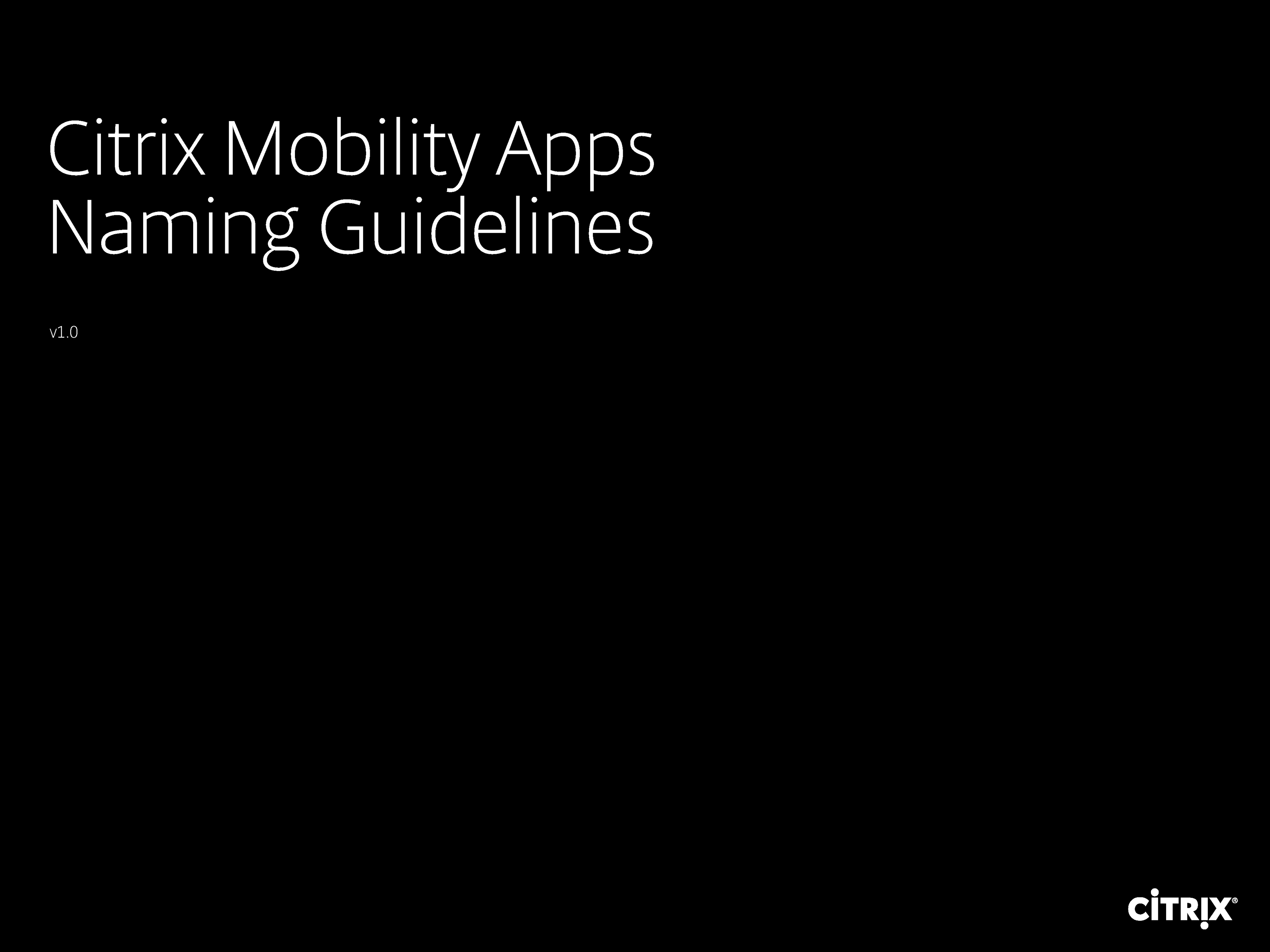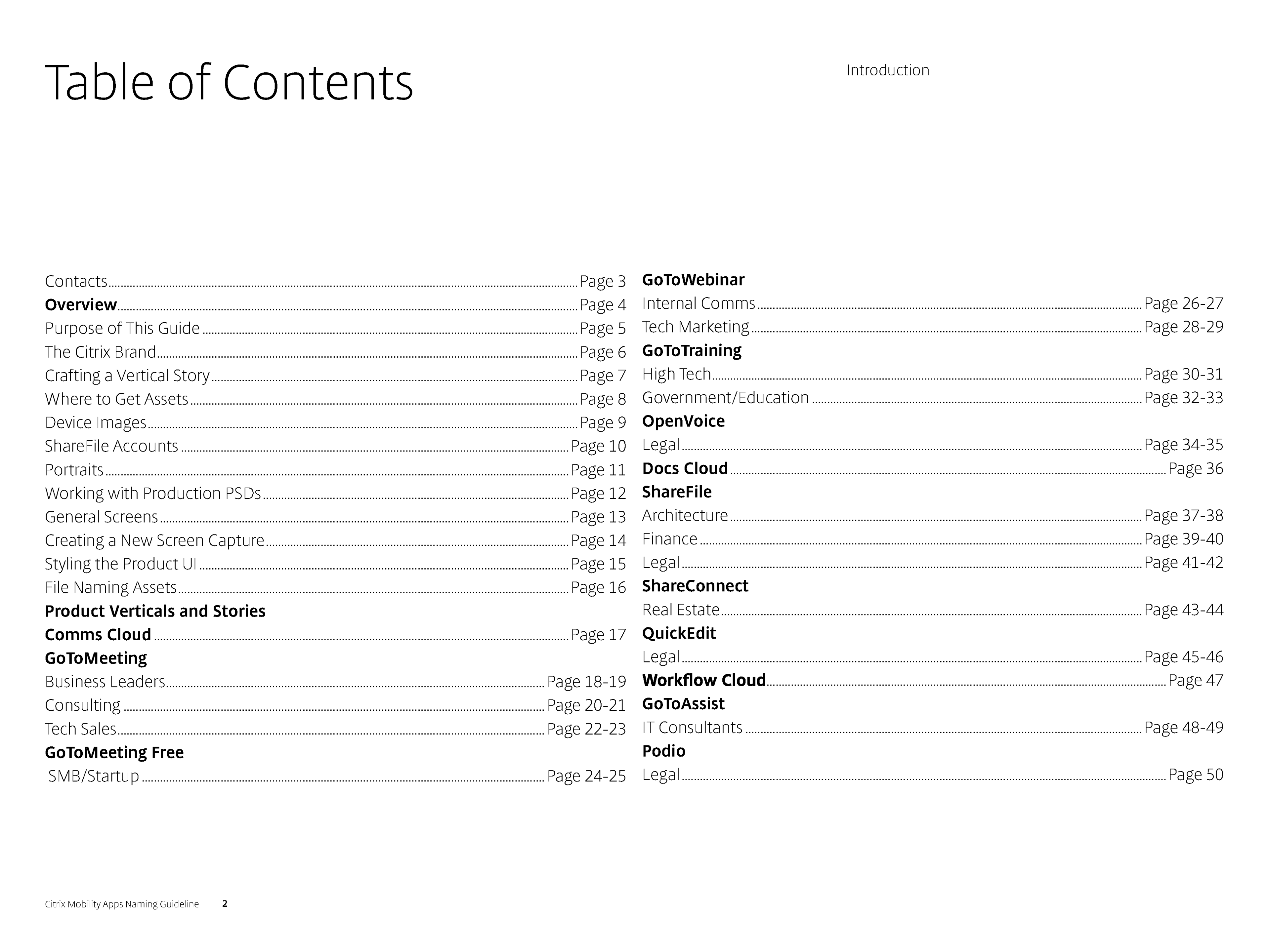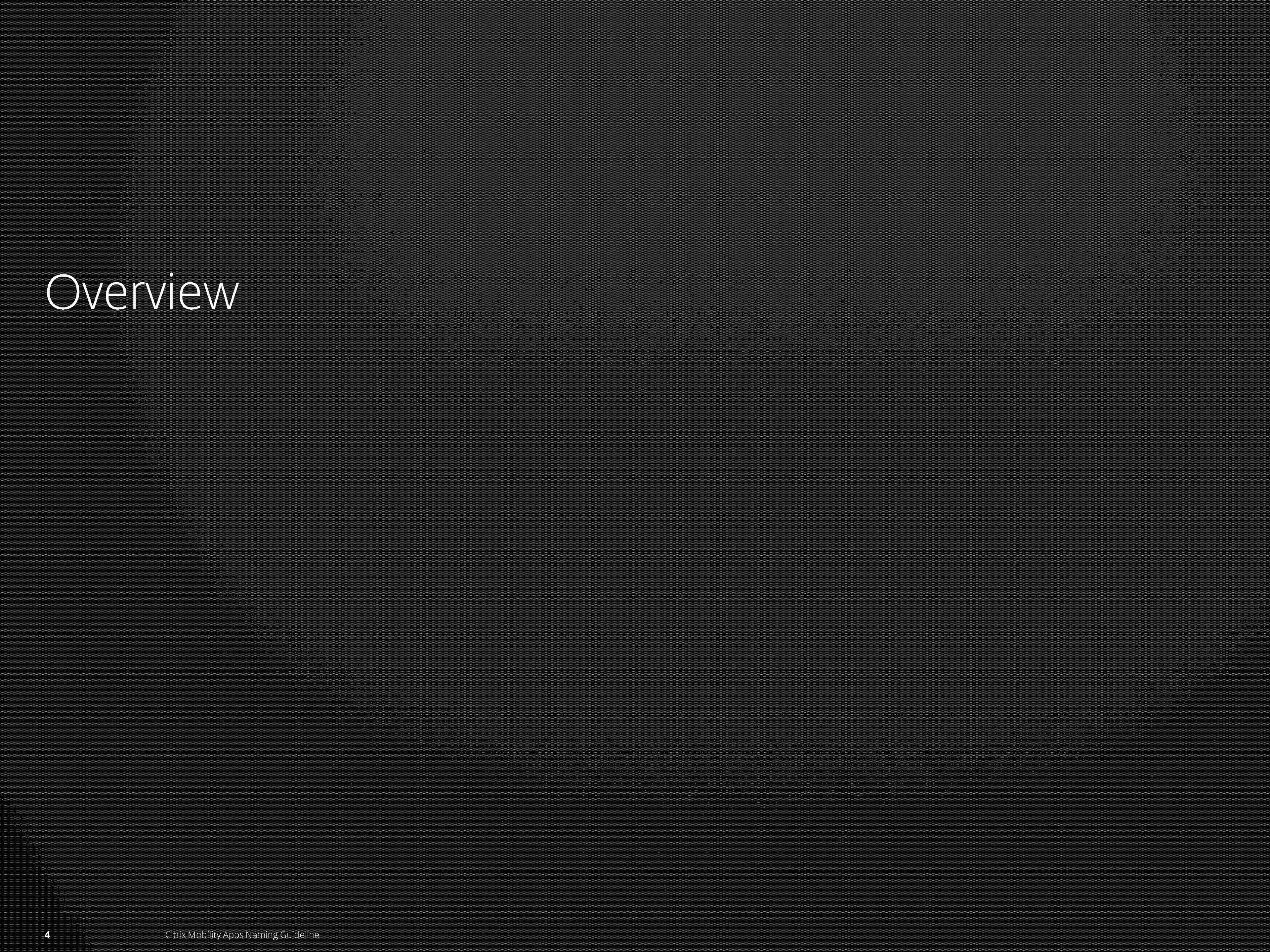Citrix Mobility Apps Naming Guidlines
Organize naming across a large portfolio of global SMB SaaS products and teams to accelerate innovation and support team autonomy while developing better usability across products for Citrix users.
Citrix Mobility Apps
Global Brand Naming Guidelines
The Challenge: Organize naming across a large portfolio of global SMB SaaS products and teams to accelerate innovation and support team autonomy while developing better usability across products for Citrix users.
Naming has a critical symbolic importance for product teams. Names make meaning, both for the users of products, as well as for the teams that create those products. As such, product teams will often get caught-up in the naming process, and this usually comes at the expense of time spent focusing on the actual design and development of the product itself. Furthermore, product teams are in a poor position to develop names in a way that helps build meaning not just within a product but across products. This can be a critical liability for products that exist within a larger product ecosystem, because how things are named across products plays a critical role in supporting usability and helping customers understand meaning and functionality across a portfolio. Additionally, naming has legal implications as well as usability and brand implications. Corporate legal teams need to understand the prospective liabilities and benefits a given name represents in order to provide counsel, rightsize their own investment in resources, and appropriately address the prospective legal risks a given name might have for the company.
As such, managing naming across a large, fast-moving technology company is what the smart kids call a nontrivial task. Any single product can have a number of semi-autonomous product development teams focused on endpoint-specific versions of a product, each with unique platform or browser-specific features or functionality. Multiply that across a number of products, and then factor in a cadre of new internally-developed innovation products trying to bring new products to market, and add to that continual M&A activity bringing new products into the portfolio that often have a completely foreign nomenclatural logic, and you have a scenario that is ready-made to cause confusion for users as they seek to do exactly what your corporate strategy seeks to drive them to do – namely, move from using just one of your products to using a number of them. So how to develop a process that helps organize naming across all of the various things that need a name – everything from new top-line products to discreet product endpoints, new product features and experimental product betas?
The Innovation: Identify the taxonomy of naming activities that exist across the company, and develop a scalable system and process to help drive a consistent brand-oriented perspective on nomenclature and meaning that helps teams innovate faster, while driving overall product usability.
The Citrix Brand Experience team took on this challenge by doing a significant amount of internal and external research. First, we did an audit of all of the naming work that the team had been consulted on over several years to identify both where we had been spending time working with various teams on naming projects, and also what the benefits (or lack thereof) had resulted from these engagements. With our own internal hypothesis around naming value in hand, we proceeded to do a significant amount of both internal user research, and external market research. Internally, we met with key stakeholders across global product teams to ascertain the needs and pain-points that existed around naming. We also met with key stakeholders on our corporate legal team to understand the needs and trade-offs inherent in the domain of trademark law. Externally, we looked at a number of large companies with diverse technology portfolios to identify external best-practices, and also to understand what customers were being exposed to when they were using other non-Citrix software products.
With all of this data in hand, we developed a formalized naming taxonomy and framework that organized the key types of naming activities unique to Citrix , and developed a series of discreet naming processes – complete with timing and Brand SLAs – that would help us rightsize time investment across naming activities.
Critical to this process development was the integration of the Citrix legal team, who had been getting inundated with trademark application requests directly from product management teams. The new process design included a formalized perspective on trademarks, where they mattered and perhaps more importantly where they didn't. This helped product teams understand where Citrix was willing to not only make investments in filing trademarks, but also ensured that the supporting work necessary to develop a trademarkable name was worth the investment in time and resources. For experimental products and teams working on product features in particular, this helped them understand where their work fit within the larger brand naming ecosystem, and helped them rightsize their activity relative to what they were working on, focusing more on product development as opposed to name/identity development.
The Transformation: With a clear perspective on naming that took into account all of the different types of naming activity at Citrix, product teams were able to spend significantly less time on naming products and features, and significantly more time developing them.
Having a clearly-articulated perspective on naming that spoke directly to the real-world naming challenges product teams faced helped dramatically scale-back naming inappropriate naming activity across products. Product teams working on specific features were freed from thinking that they needed to spend significant time coming up with creative new names once they understood that how their feature was named had implications outside of their own product. Teams working on experimental new products were able to get those experiments into users' hands significantly quicker, because we had shown the organization that spending the same resources naming experimental products was an inappropriate investment for the stage that those experimental products were at. Everyone working on a new experimental product necessarily believes that their product will become immensely successful, but the fact is that innovation is a numbers game. The naming process my team devised helped provide a balanced view on where and when to invest in naming, along with a subsequent process for handling brand and naming updates as an experimental product became more successful, potentially graduating to a top-tier place in the Citrix Mobility Apps ecosystem.
All told, the introduction and formalization of this helped Citrix radically-rightsize naming activity and investment, while at the same time ensuring greater functional and brand clarity for users, and ensuring naming supported our overall long-term brand and corporate strategy.








































You may also like
Global Visual Identity Redesign
2017
Andrulaitis + Mixon Brand Development
2017
Exploratory Brand Mood Boards
2017
Thread Recruiting Identity
2011
HiNT Identity
2017
Global Brand Design Crit
2017
Citrix GoToMeeting Competitive Intelligence and Insight
2017
Visual Product Narrative System
2017
Medlock Ames Website Packaging
2011
Citrix Mobility Apps Brand Guidelines for Social Media
2017